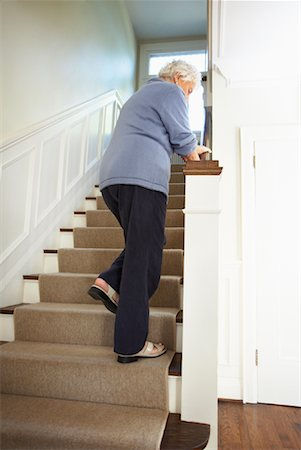Disability in Older People
- Stairlifts Expert_1_UK

- Feb 18, 2021
- 3 min read
Authored by Dr Colin Tidy, Reviewed by Dr Laurence Knott | Last edited 3 Jul 2016 | Meets Patient’s editorial guidelines
This article
According to Canadian research, five types of chronic illness contribute largely to disability in people aged over 65 years
Foot problems
Arthritis
Cognitive impairment
Heart problems
Vision
Other common or important problems include:
Hearing impairment.
Chronic respiratory and cardiovascular disease such as chronic obstructive pulmonary disease (COPD), chronic heart failure, coronary heart disease and cerebrovascular disease.
Falls and hip fracture



In frail elderly people, a marked decline in physical and mental function can result from apparently small insults. This has been called the 'domino' effect, with a small initial insult leading to a cascade of adverse events.
The normal ageing process
Age is associated with a 1-2% decline in functional ability per year. Sedentary behaviour accelerates the loss of performance. Age-associated physiological changes include:
Changes in body composition - reduction in muscle bulk and lean body mass, known as sarcopenia. Body fat may increase.
Reduction in bone mass and strength with increased risk of fracture; osteoarthritic changes in joints.
Reduction in blood volume, reduced tolerance of tachycardia; reduced ability to control blood pressure with postural change.
Reduction in ventilatory capacity.
Reduction in kidney function; impaired thirst mechanisms which increase susceptibility to dehydration.
Reduced sensitivity to vitamin D and subsequent reduction in calcium absorption.
Reduced motility of the large bowel; reduced hepatic mass and blood flow (which may affect hepatic metabolism of drugs).
Nervous system changes, including reduction in cortical function and reduced motor and sensory peripheral nerve function; changes in autonomic function, including control of heart rate and temperature regulation (failure of normal response mechanisms to hot and cold).
Reduced elasticity of the eye's lens; high tone hearing impairment.
Assessment
Assessment of a frail or disabled elderly person requires evaluation of:[11]
The damaged system.
Other body systems.
Medication - including polypharmacy.
Communication.
Cognition/mood.
Function (such as ability to perform daily living activities):
ADLs - eating/dressing/toileting/mobility.
IADLs - dealing with medication/finances/housework/transportation.
Environment - both the immediate environment (clothes and housing) and the locality (shops and social facilities).
Formal and informal supports.
Social and economic welfare.
Assessment by a specialist geriatrician and/or a multidisciplinary team specialising in elderly care can be useful.
A marked decline in function can be due to relatively small physiological insults, which may result in a frail older person being wrongly labelled as 'unable to cope'. Bear in mind that early comprehensive geriatric assessment and appropriate treatment may enable such patients to regain lost function.
Prevention of Falls in the Elderly
Falls are a major threat to older adults' quality of life, often causing a decline in self-care ability and participation in physical and social activities. Fear of falling can lead to further limiting of activity, independent of injury. Comorbidity is a serious problem both in terms of contributing to the cause of the fall and to the outcome.
Risk of injury
It is also instructive to examine the risk factors for fracture of the proximal femur. In so doing, this reveals risk factors not just for falls but for falls resulting in injury. Again, an individual may have several risk factors. These include:
Weak bones With increasing age, conditions which predispose to weakness and fracture occur - for example:
Osteoporosis
Osteomalacia
Paget's disease of bone
Metastases (to bone)
Predisposition to falls This includes the risk factors listed above as examples from research literature. Dementia is a particular risk factor for falls. In those with dementia, impaired visuospatial ability is often associated with increased risk of falling.
Poor self-protection This is common in the elderly. Examples include:
Lack of protective subcutaneous fat.
Neurological problems (preventing reflex breaking or cushioning of the the fall).
Falls associated with loss of consciousness (for example, syncope).
Motor and sensory problems.
Multiple contributory factors (for example, slow and stiff joints, drugs and environmental factors are a common combination of factors).
The scope for prevention
The scope for prevention can be appreciated by considering some of the common conditions and risk factors predisposing to falls in the elderly. From this, the wide range of preventative measures and treatment possibilities can be appreciated. Falls should be considered a symptom rather than a diagnosis, so that when a patient, usually an elderly person, presents with a history of falls, effort should be made to find the cause or causes.
A Cochrane review found that:
Group and home-based exercise programmes and home safety interventions reduce the rate of falls and risk of falling.
Multifactorial assessment and intervention programmes reduce the rate of falls but not the risk of falling.
T'ai chi reduces the risk of falling.
Environmental factors
Falls caused by accidents related to the patient's environment can often be prevented. NICE recommends that all people at risk of falls should be offered a home assessment and interventions to modify environmental hazards. For example:
Loose rugs or mats (especially on a slippery floor).
Electricity leads (trailing across the floor).
Wet surfaces (especially in the bathroom).
Lighting.
Furniture.
Fittings such as handholds.
Measures such as the installation of handles and rails can reduce the risk of falls.The community team may work in association with the local council to install these without charge to the patient.






Comments